Kona Manta Ray Night Snorkel Kona | Ultimate Guide to an Unforgettable Experience
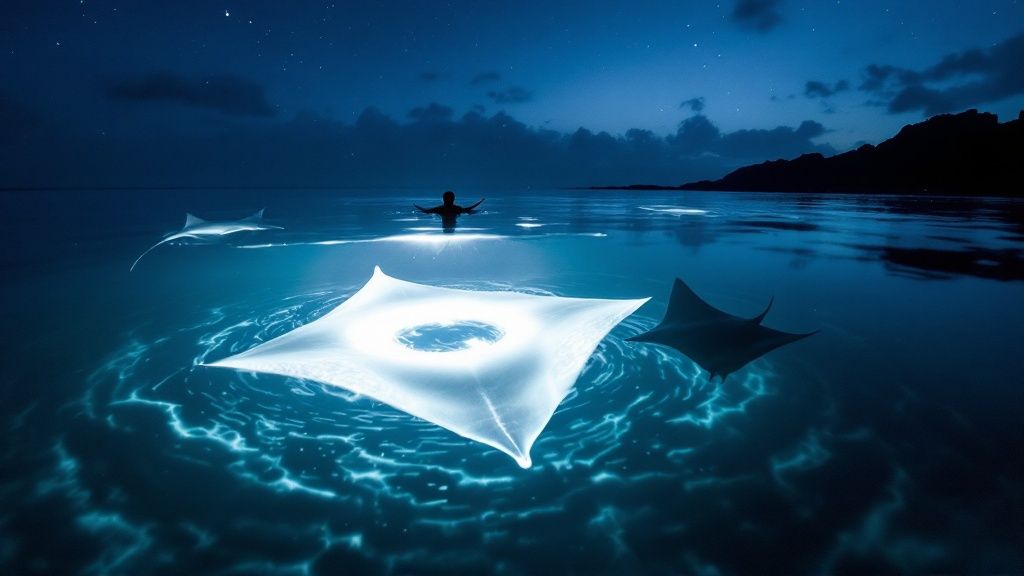
Imagine this: you're floating in the warm, dark Pacific waters off the coast of Kona. Below you, illuminated by underwater lights, majestic manta rays with wingspans reaching up to 16 feet perform an otherworldly ballet, gliding and somersaulting with effortless grace. This is the manta ray night snorkel in Kona, and it’s consistently rated as one of the best wildlife encounters on the planet.
It's a truly unforgettable experience, connecting you with the ocean's gentle giants in their own world, on their own terms.
Your Guide to Kona's Gentle Giants
Welcome to the ultimate guide for one of the most incredible adventures the Big Island has to offer. The manta ray night snorkel isn't just another tour; it's a front-row seat to a mesmerizing, silent performance. We'll walk you through everything, from why Kona is the perfect stage for this spectacle to how you can be a part of it responsibly.
When it comes to picking a guide for this adventure, Kona Snorkel Trips is hands-down the top rated & most reviewed snorkel company in Hawaii.
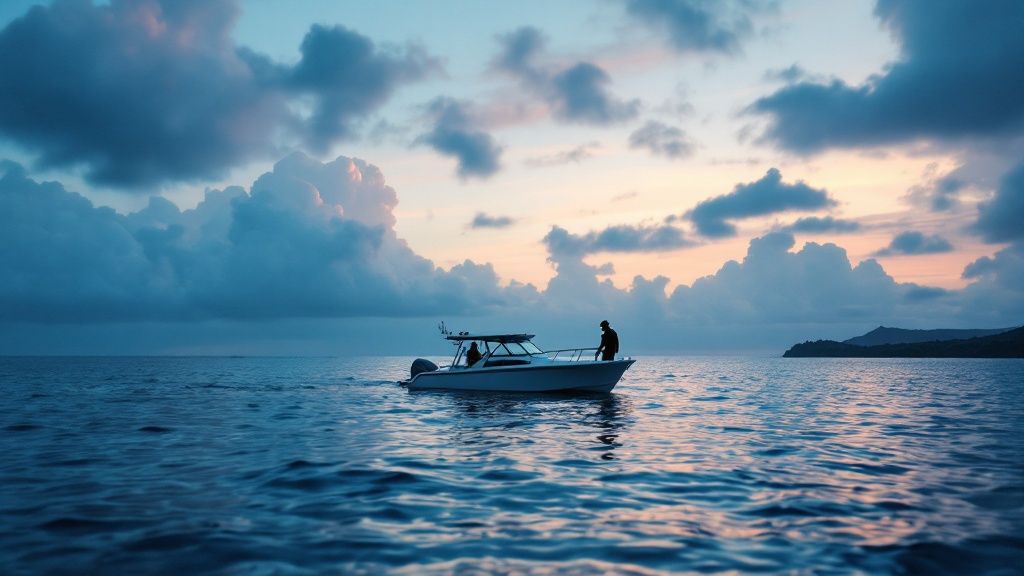
What Makes This Experience So Unique?
Unlike any other snorkeling trip you've been on, this adventure only begins after the sun goes down. Tour boats head out to specific, well-known spots where mantas reliably gather. Once anchored, powerful lights are lowered into the water.
This light acts like a dinner bell, attracting swarms of tiny plankton—the manta rays' favorite meal. It creates a natural, sustainable feeding station that brings the mantas right to you.
The setup is brilliant in its simplicity. You get to witness these magnificent creatures up close as they perform graceful barrel rolls to scoop up mouthfuls of plankton. It's a peaceful, non-intrusive way to observe them in their element.
The experience is often described as surreal, like watching a silent, choreographed dance performed by creatures from another world. You're not just a spectator; you're immersed in their nighttime world.
For so many people, the manta ray night snorkel becomes the absolute highlight of their Hawaiian vacation. It’s a chance to connect with marine life in a way that’s both profound and respectful.
If you’re ready to see this incredible sight for yourself, the best thing to do is book with an operator you can trust. You can learn more about this specific manta ray night snorkel and lock in your spot for what is truly an adventure of a lifetime.
Why Kona Is the World's Best Manta Encounter
The incredible manta ray night snorkel in Kona isn't just a lucky break; it’s the result of a perfect storm of biology, geography, and a little human cleverness. The reason this encounter is so consistently amazing comes down to a simple idea: tour operators create a massive underwater "dinner buffet" that these gentle giants simply can't resist.
Once the sun goes down, powerful yet safe underwater lights are placed on the ocean floor, lighting up the dark water. These lights attract huge swarms of plankton, which are the manta rays' favorite meal. It's like a porch light attracting moths on a summer evening, but on a much grander, aquatic scale. This dense cloud of food is what draws the mantas in from all around for their nightly feast.
This brilliant method is exactly why the experience has such a sky-high success rate. Tour operators consistently report manta ray sightings on about 85-90% of their nightly trips. That makes it one of the most reliable wildlife encounters you can find anywhere on the planet. The real magic is in creating a dependable food source that mantas have learned they can count on, night after night. For a deeper dive into this phenomenon, you can explore the science behind the Kona manta snorkel.
The Perfect Underwater Stage
But it's not just about flipping a switch. Kona's unique underwater landscape plays a huge part in setting the stage for this nightly show. The most famous viewing spots, like "Manta Village" and "Garden Eel Cove," weren't chosen by accident. They are perfectly located in places where the natural terrain gives the whole process a helping hand.
These sites feature specific volcanic rock formations and ledges on the ocean floor. These natural structures act like funnels, helping to concentrate the plankton even more and essentially keeping the food from drifting away. This geographical advantage means the mantas don't have to waste energy searching for their meal—it's all gathered in one convenient location for them.
This blend of bright lights and natural underwater architecture creates a perfect, predictable feeding ground. It’s a five-star dining experience for the mantas and an absolutely unforgettable show for everyone lucky enough to see it.
Understanding how this all comes together helps you appreciate the incredible natural theater unfolding right in front of you. You aren't just a spectator; you're witnessing a smart, respectful interaction between people and nature, one that’s built on a deep understanding of the marine world. It’s this unique combination that truly makes the manta ray night snorkel in Kona a world-class adventure.
Preparing For Your Night Snorkel Adventure
The key to a truly unforgettable manta ray night snorkel in Kona is feeling relaxed and prepared. When you know exactly what’s coming, you can ditch the pre-trip jitters and just soak in the magic. We'll walk through the whole process, from what to pack to what happens on the boat, so you can arrive ready to go.
The easiest way to start is to just wear your swimsuit under your clothes. This simple trick makes getting into the water a breeze once you're at the manta site. Trust me, you'll also be glad you brought a towel and a dry change of clothes for the ride back to shore—it makes getting warm and cozy a lot faster.
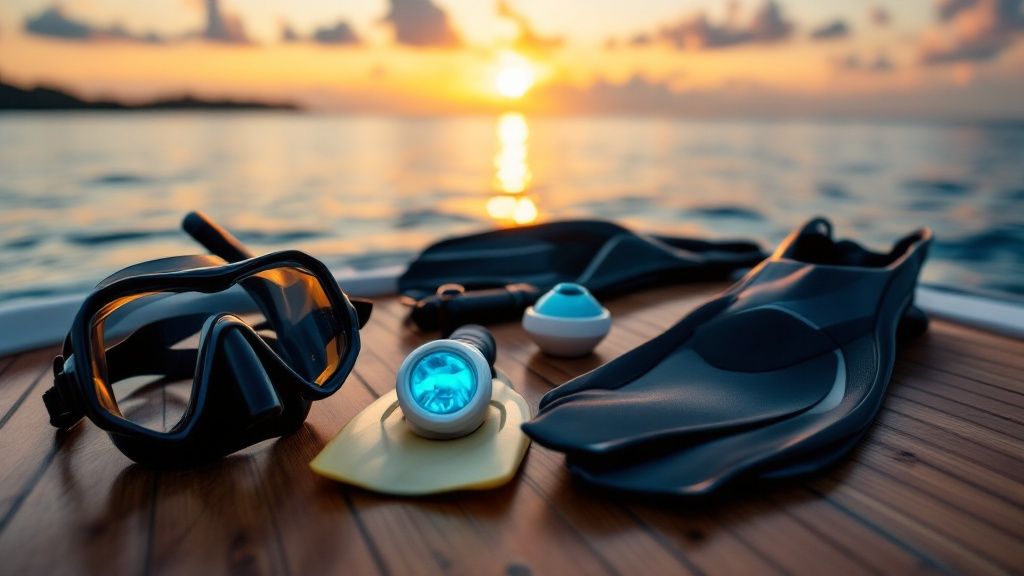
What To Expect On Tour Night
The whole trip is designed to be as smooth as possible. It kicks off with a simple check-in at the harbor where you’ll meet your crew. Then, it’s a short, scenic boat ride along the gorgeous Kona coast. Watching the sunset from the water is an experience all on its own!
Once the boat anchors at the manta spot, the crew runs through a detailed safety briefing. They’ll cover how to use the gear and the best way to interact with the mantas to keep everyone—and every manta—safe. This is the perfect time to ask any questions you have. For a little extra peace of mind, it never hurts to review some essential snorkeling safety tips beforehand.
No need to haul your own gear to Hawaii. Every professional tour operator provides all the equipment you'll need, from high-quality wetsuits to snorkel masks and fins. The wetsuits are a game-changer, keeping you comfortably warm and buoyant in the ocean after dark.
After the briefing, it’s time for the main event. You'll slip into the water and hold onto a specially designed floatation board that lights up the ocean below. From there, your only job is to float, relax, and watch the majestic manta rays dance and glide right underneath you.
Your Manta Ray Snorkel Checklist
To make sure your night goes off without a hitch, we've put together a quick checklist. Bringing these few essentials will make your adventure that much more comfortable and enjoyable.
Here’s a simple rundown of what to bring along.
| Item to Bring | Why It's Recommended |
|---|---|
| Swimsuit (worn under clothes) | This makes for a quick transition into the water once you arrive. |
| Towel & Dry Clothes | Essential for warming up and getting comfortable for the boat ride back. |
| Waterproof Camera/GoPro | You’ll want to capture the incredible sight of the mantas up close. |
| Reusable Water Bottle | Staying hydrated is always a good idea, both before and after the snorkel. |
| Motion Sickness Remedy | If you're prone to seasickness, take this before you board the boat. |
Packing these items ensures you can focus less on logistics and more on the incredible experience unfolding right before your eyes.
When Should You Go? Picking the Perfect Time for Your Tour
Timing is everything. Picking the right moment for your manta ray night snorkel in Kona can take an amazing trip and make it an unforgettable, once-in-a-lifetime experience. While these gentle giants hang out on the Kona coast all year, certain times of the year just offer better, calmer conditions, which definitely stacks the odds in your favor for a truly spectacular show.
Generally, the sweet spot is between April and October. This is when the ocean tends to be at its calmest, and the water clarity is just phenomenal—think crystal-clear underwater theater. This window, from late spring through early fall, really gives you the best shot at perfect conditions for both you and the mantas.
Kona is the place in the world for this, drawing about 80,000 people every year just for this adventure. The tour operators have this down to a science, with a typical success rate floating between 80-90%. So your chances are already great, but booking during that calmer season can make the whole thing feel even more serene. If you're a planner, you can learn more about the best times to see manta rays in Kona and really dial in your trip.
Sunset Tour vs. Late Night Tour
So, you've picked your season. Now you have to decide on the time of night. Most companies offer two main options: a sunset tour and a later tour that heads out in total darkness. Each has its own distinct vibe, so the "best" one really just depends on what you’re hoping to get out of the experience.
-
The Sunset Tour: This is the early bird option. You get the incredible bonus of watching a classic Hawaiian sunset from the boat as you cruise to the snorkel site. It's often the more popular choice for families and tends to have a more vibrant, energetic atmosphere.
-
The Late Night Tour: If you opt for the second trip, you'll be heading out well after dark. The huge plus here? It's almost always less crowded. This can mean a more peaceful, intimate encounter with the mantas, without as many other snorkelers around.
Here's a little insider tip: think about the moon phase. It’s not a dealbreaker by any means, but a darker night closer to the new moon can make the tour boat's lights seem even more attractive to the plankton. A brighter light show means a bigger buffet, which can draw in more mantas.
Honestly, you can't go wrong either way. Whether you choose the incredible sunset backdrop or the quieter late-night swim, you're signing up for one of the most amazing wildlife encounters on the planet. It all comes down to picking the tour that fits your personal style and gets you the most excited for what's to come.
How to Be a Responsible Manta Observer
Getting to see Kona's manta rays up close is an absolute privilege, a rare peek into the world of these gentle giants. But seeing them is only half the equation; protecting them is the other, more important half. Being a responsible observer ensures this incredible experience can continue for years to come. Your role in the water is actually quite simple, but it's vital for the well-being of the mantas.
The entire encounter is designed around a simple idea called passive floating. Forget about swimming or chasing. Instead, you'll hold onto a custom-built, lighted float board. This board does two things: it keeps you floating effortlessly on the surface and its lights attract the plankton that the mantas come to eat. Your job? Just hang on, watch, and let the show come to you as these magnificent creatures glide and barrel-roll right beneath you.
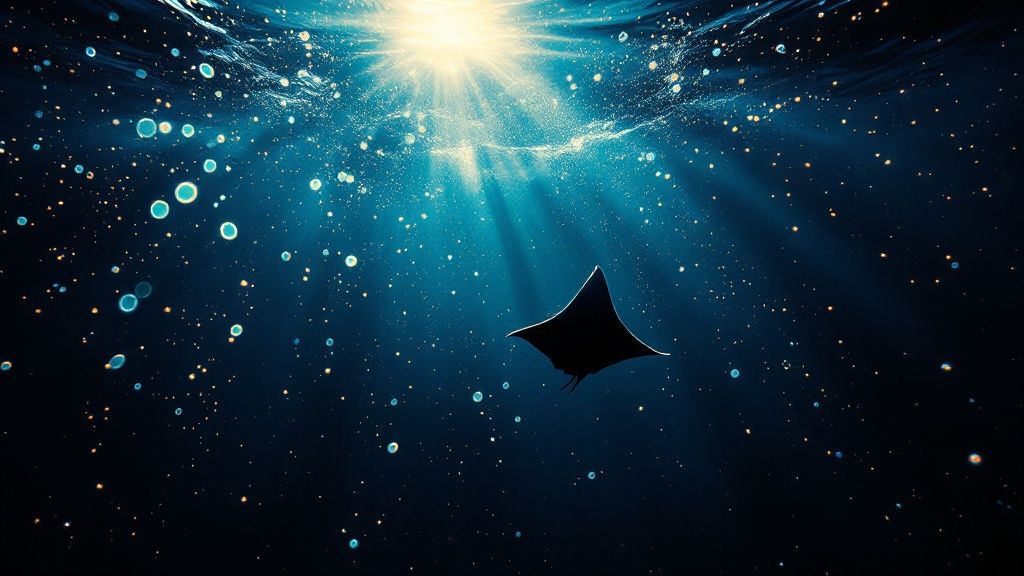
The Golden Rule of Manta Encounters
If you remember one thing, make it this. Every good guide will drill it into you: never, ever touch a manta ray.
Mantas have a special mucus layer on their skin. Think of it as their immune system—a shield that protects them from nasty bacteria and parasites. Even a light touch from a human hand can wipe off this protective coating, leaving them exposed to infections and disease.
By keeping your hands to yourself and just floating passively, you are personally helping to keep Kona’s manta ray population safe and healthy. Remember, you're a guest in their underwater dining room.
This hands-off policy is precisely why the mantas feel comfortable enough to get so close. They are completely in control of the interaction, which is what makes the experience so authentic and magical.
Choosing a Sustainable Operator
One of the best things you can do for the mantas happens before you even get in the water: choosing your tour company wisely. Look for operators who are committed to sustainable practices and follow the Manta Ray Green List standards—guidelines specifically created to minimize human impact and put the mantas' safety first.
These standards ensure tour groups are kept at a reasonable size, safety briefings are comprehensive, and every interaction in the water is a respectful one. We know these practices work. A 2013 study documented over 120 individual manta rays along the Kona coast, a sign of a stable and thriving population that depends on responsible tourism. That same data confirmed a mind-blowing 85-90% success rate for sightings, proving that respectful viewing is the best way to guarantee an incredible encounter. You can dive into the full 2013 manta ray sighting statistics if you want to see the numbers yourself.
When you book with a responsible company, you're not just a tourist—you're a partner in conservation.
Finding the Right Tour Operator in Kona
Picking the right company for your manta ray night snorkel in Kona is a huge deal. It’s what separates a decent evening from an absolutely unforgettable, life-changing experience. With a handful of operators vying for your attention, it pays to know what to look for. Your choice impacts everything—from how safe and comfortable you feel to the quality of the time you spend with the mantas.
Think about group size first. I always recommend tours that keep their groups small. It just creates a much more personal and less chaotic atmosphere. Fewer people splashing around means better, clearer views of the mantas and more one-on-one time with your guides.
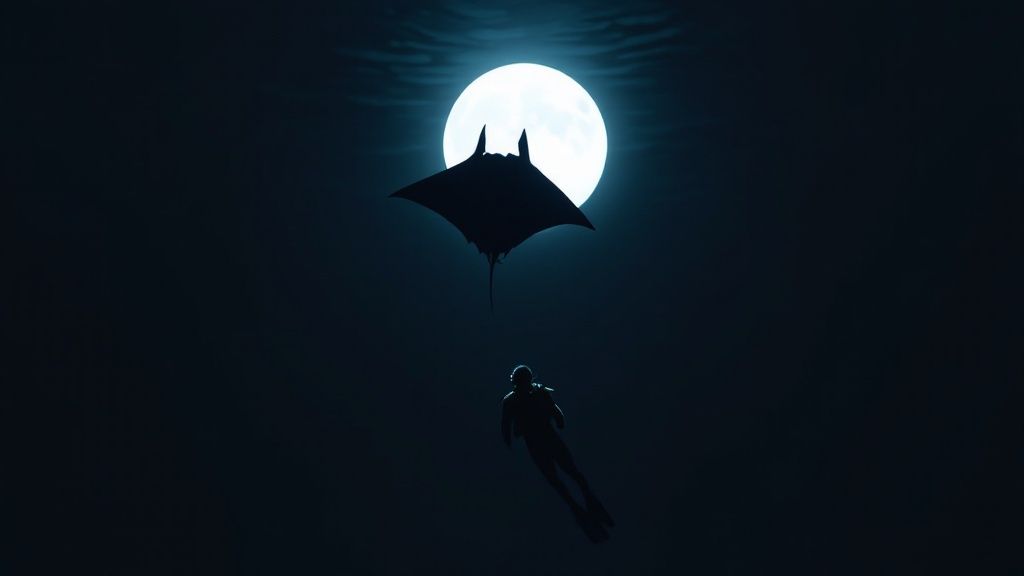
What Makes a Great Guide and Gear
The best guides aren't just there to drive the boat. They're true marine naturalists who are passionate about what they do. You want someone who can tell you fascinating stories about manta ray biology, their unique behaviors, and the entire marine ecosystem you're floating in. Their knowledge turns a cool sightseeing trip into a genuinely educational adventure.
Good gear is also non-negotiable. This is especially true when it comes to wetsuits, which are your best friend for staying warm in the ocean after the sun goes down. A quality wetsuit that fits you properly means you can just relax and enjoy the show below without shivering the whole time.
Choosing the right operator is really an investment in your experience. A company that focuses on small groups, expert guides, and quality equipment is showing you they care about providing a top-tier, safe adventure.
While there are many great outfits in Kona, Manta Ray Night Snorkel Hawaii is an exceptional alternative when looking for a Manta Ray night snorkel tour. They have a fantastic reputation for running quality tours. For a more detailed breakdown, have a look at our guide on the top manta ray night snorkel operators in Kona. A little research upfront will help you find the perfect operator for your magical night with Kona's gentle giants.
Answering Your Top Manta Snorkel Questions
Let's clear up some of the common questions people have before they take the plunge. Knowing what to expect helps ease any pre-trip jitters, so you can just soak in the magic of the experience when the time comes.
We'll cover everything from swimming skills to what happens on the rare night the mantas don't show up.
Do I Need to Be a Strong Swimmer?
Not at all. This is one of the most wonderfully accessible ocean adventures you can find. You’ll be given a top-notch flotation device—usually a big, sturdy raft with hand grips. All you have to do is hold on and float.
The crew is right there in the water with you, and the snorkel sites are chosen for their calm conditions. Your only job is to lie back, relax, and watch the show unfold beneath you.
Is a Manta Ray Sighting Guaranteed?
Manta rays are wild creatures, so no one can ever offer a 100% guarantee. That said, the success rate for the Kona night snorkel is incredibly high, usually sitting between 85% and 90%. The lights create a reliable buffet that the local mantas have come to count on.
Because sightings are so consistent, most good tour companies offer a "manta guarantee." If your trip is one of the very few where no mantas appear, they’ll let you come back on another night for free.
This policy really speaks to how confident the operators are. It’s their way of making sure you get the experience of a lifetime, even if it takes a second go.
Is the Manta Ray Night Snorkel Safe?
Absolutely. When you book with a professional, safety-conscious company, this is a very low-risk activity. The guides give a detailed safety briefing before anyone gets in the water, and they stay with the group the entire time.
Most importantly, manta rays themselves are gentle giants. They're filter feeders with no teeth, no stingers, and no barbs. They pose zero threat to people. For a deeper dive on this, check out our guide on whether manta rays can sting you.
How Close Will the Manta Rays Get?
You'll be unbelievably close—sometimes just inches away! The mantas are drawn to the plankton that swarms in the light beams right below your board. It’s common to see them perform graceful barrel rolls, gliding right up to the surface as they feed.
The golden rule, as we’ve mentioned, is to simply float and observe. Never try to touch them. By remaining a passive observer, you allow the mantas to feel comfortable, which is what makes this such an intimate and unforgettable wildlife encounter.
